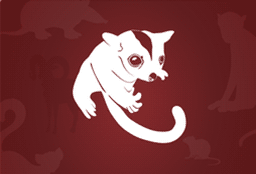The striped marsh frog or brown-striped frog is a common species in urban habitats It is a mostly aquatic frog native to coastal Eastern Australia.
A pale to grey-brown back with darker brown stripes. Usually also a pale stripe running down the middle of its back. Its belly is white and often flecked with brown, and there are dark spots and stripes on its limbs.
Size
4.5 - 7.5 cm
Grey soft fur, with a white belly and a black stripe that runs from its nose, over its head and along its back. It has a long bushy tail, the last quarter of which is black, often with a white tip. Its ears are large and hairless, and its large eyes are black.
Size
About 28 cm long (from nose to tip of tail).
Metallic blue-black on top and light to dark grey on its breast and belly. Its forehead, throat and upper breast are rust in colour. It has grey legs and feet, and its eyes and bill are black. A young Welcome Swallow has shorter tail feathers than an adult and its forehead and throat are a creamy beige (instead of rust).
Distinctive feature
A deeply forked tail with a white band or row of spots on the long tail feathers.
Also known as Cape Lilac. It reaches maturity when it is 6 – 10 years old and lives for about 20 years.
Deciduous tree, usually 10 – 15 m high but can reach 45 m in its natural environment. Its canopy is 6 – 8 m wide.
Leaves
Bright glossy green and oval in shape, 2 – 7 cm long and 1 – 3 cm wide. They are arranged either side of a 12 – 45 cm long stem and turn yellow in late autumn before falling from the tree in winter.
Flowers
Pale purple to white, star-shaped, forming clusters that are 10 – 20 cm long. Each individual flower is about 2 cm in diameter and consists of 5 petals. The flowers have a chocolate scent!
It has dark brown to black fur with a bright white-stripe at the junction of the body and wings. Some individuals also have an area of white-fur on the chest.
One of the largest insectivorous (microbats) in Australia, it is in the ‘free tail’ family (Molossidae) which have a strong, stiff tail projecting beyond the tail membrane.
The species was formerly classified as Tadarida australis.
Size
85 - 100 mm head and body length; free tail extends 40 to 55 mm from the body. Adult average weight 37 g.
One of Australia's most widespread birds on mainland.Mostly black with a white belly and eyebrow. A young bird has paler, slightly rusty edges to its wing feathers.
Size
18 - 22 cm long (from head to tail)
Dark grey-brown above with some brown streaking. It is paler below with lighter streaks and has a slightly down-curved bill. Young birds are paler.
Distinctive feature
A broad yellow facial stripe across its eye which is bordered with black.




